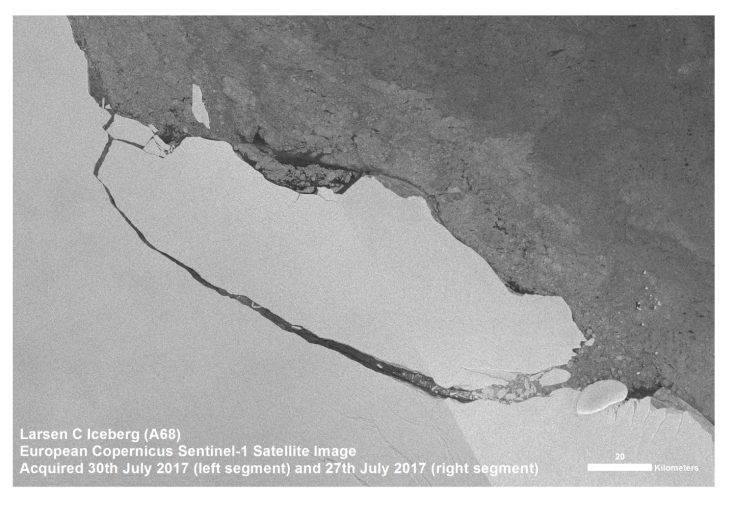Antarctica's trillion-tonne iceberg might 'bump back into Larson C ice shelf'
There are several possibilities for what will happen to the berg next.

The iceberg a quarter of the size of Wales that broke away from Larsen C on 12 July is floating about 5 kilometres away from the main ice shelf. Scientists are tracking it closely to see if it is likely to float on, get stuck or float back towards the ice sheet.
It's not known if the iceberg will stay in one piece or break into many smaller ones. A dozen smaller bergs have appeared in its wake, still measuring more than 13km across. They have come both from the main ice sheet and from the iceberg itself, according to a study in the journal Nature Climate Change.
If the iceberg was forced back towards the ice shelf then would put a huge amount of stress on Larsen C, which lost 10% of its mass to the iceberg.
"The only way this iceberg could now impact Larsen C is if it's blown back toward the ice shelf and bumps into it," study author Anna Hogg of the University of Leeds told IBTimes UK. "If it knocks against ice that's floating in the sea then that could potentially be a problem. But we don't know yet if that will happen."
If the iceberg blows in the other direction and moves away, then it won't directly cause any more disintegration of the ice sheet, Hogg said. But the loss of the iceberg could have a more indirect destabilising effect on the ice in the region.
Hogg and Hilmar Gudmundsson of the British Antarctic Survey, also an author of the study, are tracking the iceberg and the ice sheet's every movement using the European Space Agency and European Commission's Copernicus Sentinel-1 satellite. Measuring the ice flow of the shelf, which floats in the sea, and the ice sheet behind it attached to the land, remains crucial.
"Ice flows in same way as a river does, just much more slowly. If the ice speed has changed on the ice shelf that's less of a concern. That's always floating in equilibrium with the ocean and doesn't contribute to sea level rise.
"If we see a speeding up of the ice that is grounded, then that could have ipmcliations for sea level rise. We need to continue closely measuring changes in ice speed."
Other features that the scientists are keeping an eye on include a series of cracks in the ice that remains. These cracks have continued to grow slightly, and may come close to the Bawden Ice Rise – a point where the ice shelf passes over an underwater mountain that acts as a pin in the ice.
"We expect there would be large effect on the ice sheet if they grow towards the ice rise," Hogg said.
"This is an important feature for the ice shelf. The protruding bits of bedrock provide structural support to ice shelf. It's almost like a scaffold or a pillar, so they're particularly important for shelf stability."

© Copyright IBTimes 2024. All rights reserved.






